Common Issues with Conifer Trees in Montana
Conifers are a staple tree in many landscapes, but they can be affected by diseases and arthropod-related issues, resulting in needle discoloration, loss, and dieback of branches. Additionally, most conifer issues are not due to an insect or disease. Instead, many symptoms result from growing conditions or weather. In other cases, growth is normal but may look different than expected.
SPRING ABIOTIC DISORDERS OF CONIFERS
Winter Injury
This injury happens when there is minimal snow cover and low humidity over the winter, causing conifers to dry out. Symptoms include red, yellow or brown needle discoloration appearing in the spring, especially on needle tips. Damage is most obvious on south and southwest sides of the tree. Water thoroughly during dry periods during the growing season and into the fall to avoid this issue.
Seasonal Needle Drop
Did you know that conifers naturally shed some of their needles every year? In the fall you might notice interior needles turning yellow, and these usually turn brown and fall off in the winter. A few trees might have interior brown needles that hang on until spring.

Seasonal needle drop Photo: Eva Grimme
Normal Plant Growth
Sometimes the way trees normally grow can look surprising to a homeowner. For example, if a conifer has more pollen cones than usual it might cause a second look. Another example is certain trees with a characteristic like shredding bark.
COMMON DISEASES OF CONIFERS
Spruce Diseases
Needle Cast Diseases: Brown, bronze, or dark purple discoloration and gradual loss of innermost needles. Symptoms often start on lower branches. Youngest needles usually stay green.
- Rhizosphaera needle cast: Small, black, spherical fruiting bodies emerge from stomata.
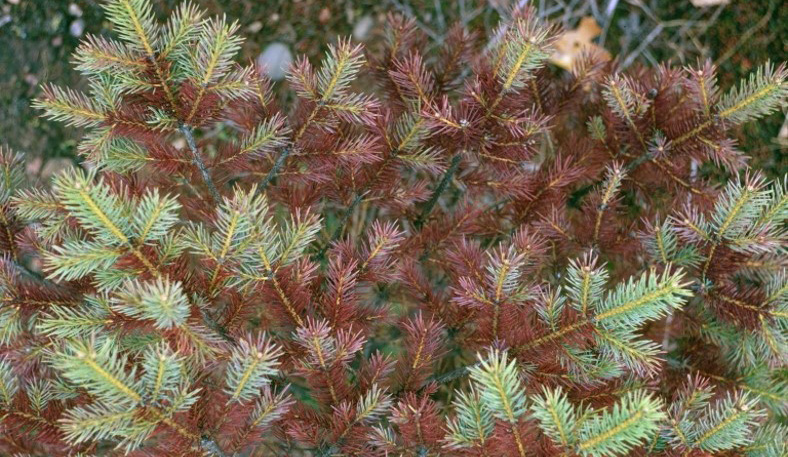
Rhizosphaera needle cast. Photo: USDA Forest Service - North Central Research Station, Bugwood.org
- Stigmina needle cast: Small, black, fuzzy-looking fruiting bodies emerge from stomata.
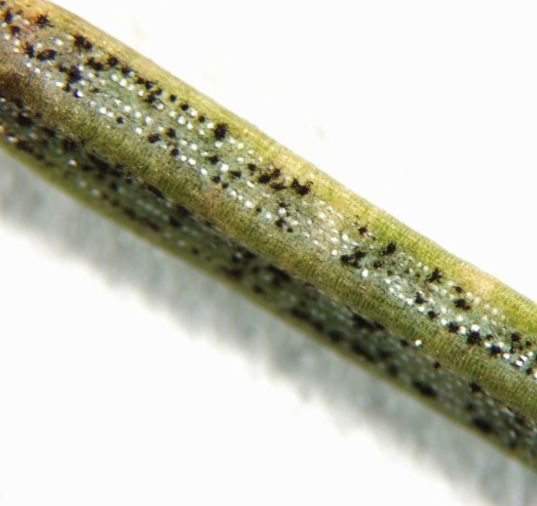
Stigma needle cast. Photo: Joseph OBrien, USDA Forest Service, Bugwood.org
- Sudden needle drop: Small, spherical, fruiting bodies form only on branches or needle pegs.
Recommendations: Remove and destroy affected branches and fallen needles. Provide supplemental water during dry periods. Avoid spraying the needles with water during sprinkler irrigation. In severe cases, consider applying a protectant fungicide in spring, once when new needles are half their mature length and once when fully grown. Treatments for two consecutive years are recommended.
Cytospora Canker: Canker develop on branches and/or trunks of stressed trees and may girdle limbs from within. Bluish or whitish resin might be visible on the branches.
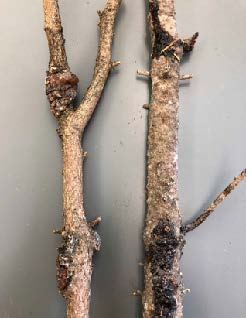
Cytospora Canker: Photo: Jane Wolery, Eva Grimme
Recommendations: Prune out and destroy affected branches. Support tree vigor by providing adequate water and nutrients. Fungicides are not recommended.
Pine Diseases (primarily Austrian, ponderosa, mugo)
Dothistroma needle blight: Tan or brown needle tips (often with a distinct interface between dead and live tissue) that start as dark-green (water-soaked), tan or reddish-brown spots, eventually forming a band (possibly with small resin drops) around needles; dark fruiting bodies emerge from needles.
Recommendations: Remove fallen needles. In spring, consider applying a protectant fungicide once when new needles are half their mature length and once when fully grown.
COMMON ARTHROPOD ISSUES ON CONIFERS
White Pine Weevil (spruce):
The top of the tree (terminal) will wilt and eventually die. Side branches will start to grow upward to replace the dead leader.
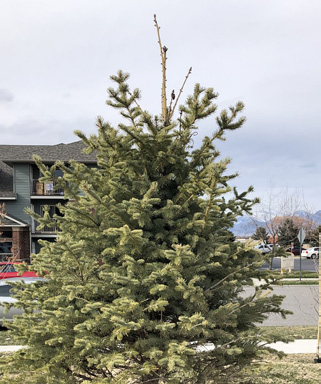
White Pine Weevil: Photo: Laurie Kerzicnik
Recommendations: The infested terminal can be clipped, and a new leader can be trained (before July). Contact insecticides can be sprayed at the terminal of the tree or a systemic insecticide can be applied as a soil drench in the spring.
Western Spruce Budworm (Douglas-fir, fir, spruce, and larch):
Several areas of the tree will be defoliated. Needles will be deformed with chewing damage, insect excrement, and webbing.
Recommendations: Beneficial predators help to control populations. Several contact insecticides are available for caterpillar control.
Spruce Spider Mite (spruce, fir, pine, juniper, arborvitae, Douglas-fir, and yew):
Needles will have a greyish hue with flecking spots. Stunting and premature needle drop can occur. Damage is usually concentrated on the older, inside needles in the lower portions of the tree.
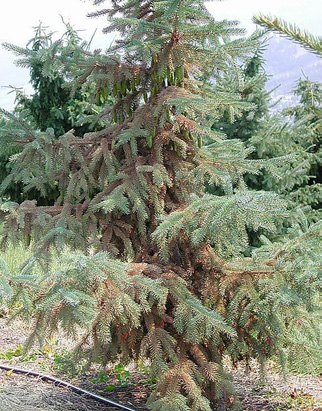
Spruce Spider Mite. Photo: Ward Strong, BC Ministry of Forests, Bugwood.org
Recommendations: Reduce environmental stress to the tree and provide adequate water. Several oils and miticides are available for spider mite control.
Ips Bark Beetles (and close relatives) (pine and spruce):
Ips beetles cause fading of needles and eventual dieback on branches or tops of trees (can also be confused with abiotic-related issues). Trees that are newly transplanted, have root injuries, or are stressed are more susceptible to Ips beetle attacks. Woodpeckers might be seen feeding on the immature beetles underneath the bark.

Ips Bark Beetles Photo: S. Katovich, Bugwood.org
Recommendations: Terminal flagging or dieback in the upper canopy requires a sample taken from this area of the tree to rule out bark beetle-related causes. It is hard (if not impossible) to kill the beetles and correct damage once they are present in the tree. Preventive contact insecticides can be sprayed on the trunk of trees that are not infested. Slash from infested trees should be piled and burned prior to adult beetle emergence in May.
Eva Grimme is an Associate Extension Specialist & Plant Disease Diagnostician. Laurie Kerzicnik is an Associate Extension Specialist and Insect Diagnostician. Noelle Orloff is an Associate Extension Specialist and Plant Identification Diagnostician.
